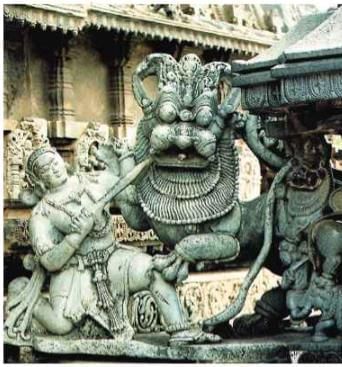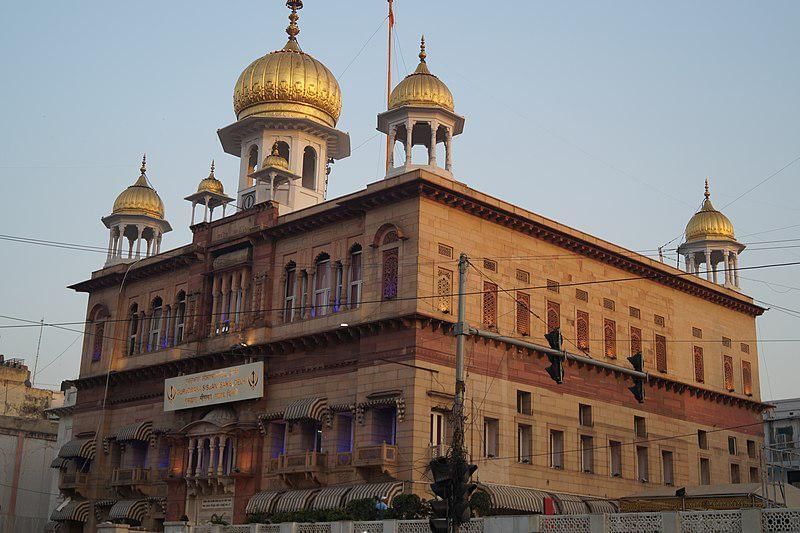Reshaping India’s Political Map Chapter Notes | Social Studies (SST) Class 8 PDF Download
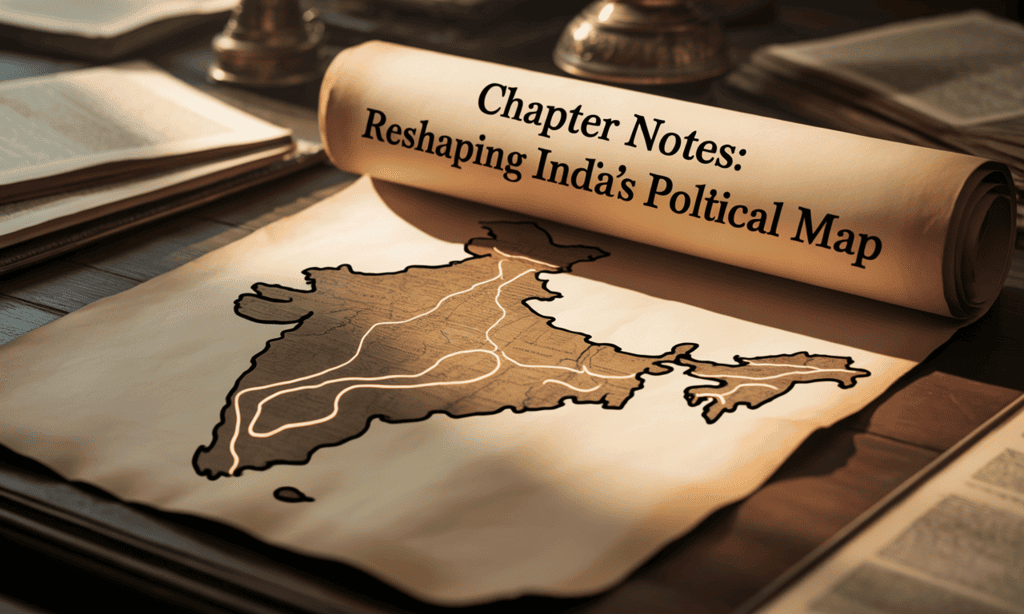
Introduction: The Medieval Period in Indian History
Have you ever wondered why India’s rulers and borders changed so often, or what made this land so attractive to invaders?
The word medieval means “between two ages.” In European history, it describes the time between the fall of the Roman Empire in the 5th century CE and the Renaissance in the 14th–16th centuries.
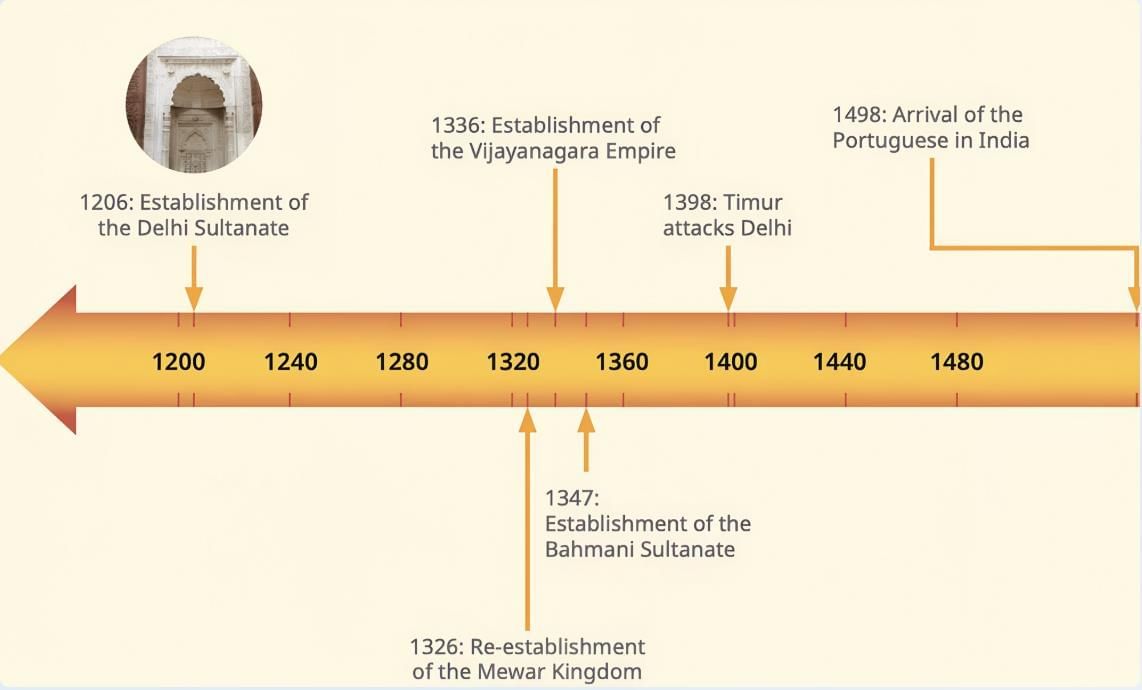
In Europe, this was once considered a “dark age” before the rise of modern science. However, India’s history was very different, so the same term does not fit perfectly here. Historians also do not agree on the exact period it should cover in India. For our study, the medieval period is taken as the time from the 11th to the 17th centuries.
Differences in spelling appear because Persian words were transcribed differently into Roman script. For example, Khalji and Khilji refer to the same dynasty, and Mughal may also be written as Mughul or Moghul.
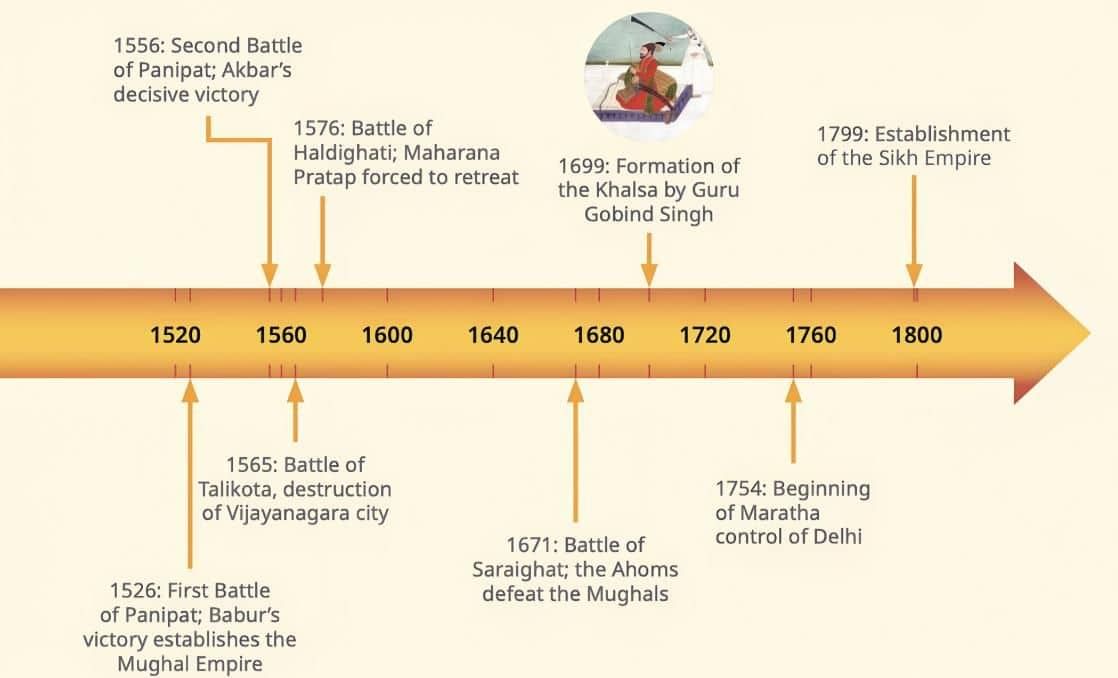
- During this era, many rulers from Central Asia (such as Turks and Afghans) invaded India, chasing wealth, territory, or to spread their own beliefs.
- These invasions and wars caused old kingdoms to fall and new empires to rise, constantly redrawing India’s political map.
- You'll notice different spellings for some rulers and dynasties (e.g., Khilji/Khalji, Mughal/Moghuls) due to language differences.
- Key dates and maps are provided—use them to trace the movements of armies, see how kingdoms changed, and follow the rise of new cultures.
A new era in Indian history began in the early 11th century, when invasions from beyond the Hindu Kush mountains reshaped the political map of India.
While India had witnessed wars in earlier times, the invasions of this period were more frequent, larger in scale, and had a lasting impact. Most of the invaders were from Central Asia, especially Turks and Afghans.
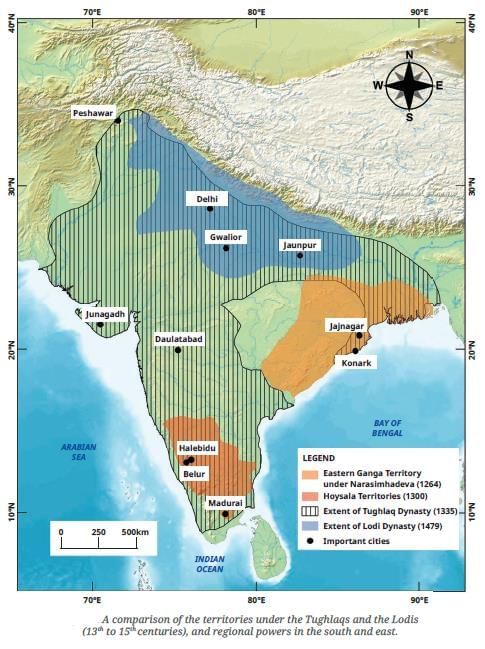
The invaders came for several reasons: India’s legendary wealth, the desire for territorial expansion, and sometimes the aim to spread their own religion, even through violence if necessary.
From the 13th century onward, India’s political and cultural landscape kept changing continuously under the influence of these invasions and the new powers that rose and fell.
As you read, consider how invasions and the arrival of new rulers transformed medieval India into a land of constant change and creativity.
Rise and Fall of the Delhi Sultanate
The Delhi Sultanate was established in 1192 after Prithviraj Chauhan was defeated and saw the rule of five Turkic-Afghan dynasties. Its rule was marked by ambitious expansion, frequent conflicts, and political instability, which ultimately led to its decline.
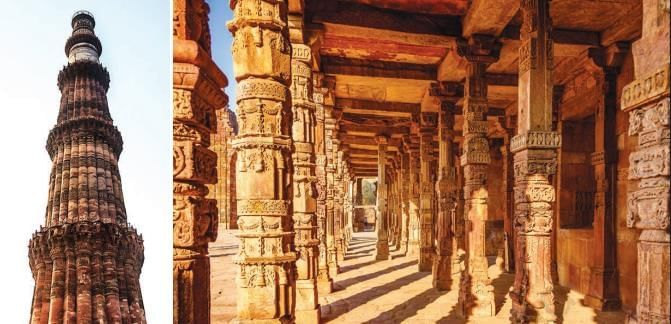 The Qutub Minar. Its construction began in Qutub-ud-din Aibak’s time (early 13th century)
The Qutub Minar. Its construction began in Qutub-ud-din Aibak’s time (early 13th century)
Formation of the Delhi Sultanate
- The Delhi Sultanate was established in 1192 following the defeat of King Prithviraj Chauhan in northwestern India.
- It was governed by five successive dynasties, all of Turkic-Afghan descent: the Mamluks (Slave dynasty), Khiljis, Tughlaqs, Sayyids, and Lodis.
- While the Sultanate dominated much of northern India, several kingdoms in the south and east resisted its influence.
- Among these were the Eastern Gangas in the east and the Hoysalas in the south, who continued to develop their own culture and administration.
- The city of Delhi became increasingly important in the political sphere of northern India.
Political Instability and Expansion
- The period of the Sultanate was marked by frequent wars, raids, and looting of villages, towns, temples, and educational centres to gain wealth.
- Political power was often unstable: nearly two-thirds of the sultans came to power by eliminating their predecessors, resulting in violent succession crises and brief reigns.
- Consequently, a sultan’s average reign lasted only about nine years.
- Ala-ud-din Khilji, one of the most notable leaders, initiated extensive military campaigns in northern and central India, plundering numerous cities.
- He successfully defended against Mongol invasions, who sought to expand their empire into India.
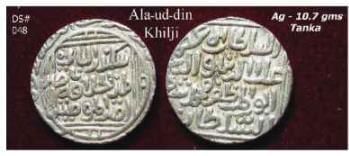 A coin minted by Ala-ud-din Khilji
A coin minted by Ala-ud-din Khilji
Military Campaigns and Plunder
- Ala-ud-din Khilji aggressively expanded the Sultanate and employed his slave general Malik Kafur to conduct raids deep into southern India.
- Malik Kafur conquered significant kingdoms, including Srirangam, Madurai, and Chidambaram, and possibly Rameswaram.
- The wealth gained from these campaigns financed the Sultanate’s large and powerful military.
Failed Policies of Muhammad bin Tughlaq
- Muhammad bin Tughlaq presided over the largest empire since the Mauryan period, temporarily uniting most of the Indian subcontinent.
- He tried ambitious reforms, such as moving the capital from Delhi to Daulatabad to enhance control, but this caused significant hardship as people had to travel over 1,000 km; the capital was later returned to Delhi.
- He introduced a ‘token currency’ system, declaring copper coins equivalent to silver or gold, but this led to confusion and widespread counterfeiting, severely impacting trade and the economy.
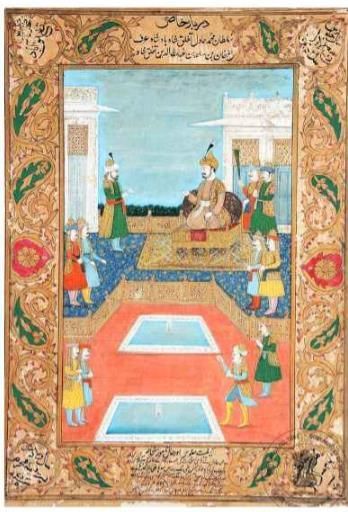 A 19th-century painting depicting Muhammad bin Tughlaq in his court
A 19th-century painting depicting Muhammad bin Tughlaq in his court
Wealth and Lifestyle of the Sultanate
- The sultans and their elites enjoyed a life of luxury, living in grand palaces and wearing fine clothing and jewellery.
- Their wealth primarily came from loot from military campaigns, taxes imposed on common people and conquered regions, and involvement in the slave trade.
- Many enslaved individuals were used as free labour or sold to Central Asia, contributing to the Sultanate’s economy.
Impact on Society and Culture
- Some of the sultans introduced the jizya, a tax on non-Muslim subjects that provided them with protection and exempted them from military service.
- Depending on the ruler, this tax often caused economic hardship and public humiliation, serving as a financial and social push for people to convert to Islam.
Decline and Timur’s Invasion
- At the close of the 14th century, Timur, a harsh Turkic-Mongol conqueror from Central Asia, invaded northwest India and launched a severe attack on Delhi, which was then a prosperous city.
- In his memoirs, he stated that his two main goals were to wage "war with the infidels" and to enrich himself by plundering their wealth. Many were killed or enslaved, and the city was left devastated.
- Timur eventually retreated from India with vast riches, leaving behind a trail of destruction.
- Following this chaos, the Lodis rose to power, establishing the last dynasty of the Delhi Sultanate.
- However, by this time, its territory had significantly reduced due to growing opposition from other states and kingdoms within India.
Resistance to the Delhi Sultanate
The Delhi Sultanate faced strong opposition from many kingdoms and regions throughout its rule. Key resistances included:
Resistance by Eastern Ganga Kingdom:
- The Eastern Ganga kingdom, covering present-day Odisha, parts of Bengal, and Andhra Pradesh, was never subdued by the Delhi Sultanate. It was known for its cultural richness and military might.
- In the mid-13th century, Narasimhadeva I (also known as Narasingha Deva I) became famous for both his military strength and the kingdom's cultural achievements.
- He successfully resisted multiple attacks from the Sultanate and defeated the governor of Bengal sent by the Delhi Sultanate.
- To celebrate his victories, Narasimhadeva I constructed the famous Sūrya temple at Konark, which remains a symbol of cultural and military pride.
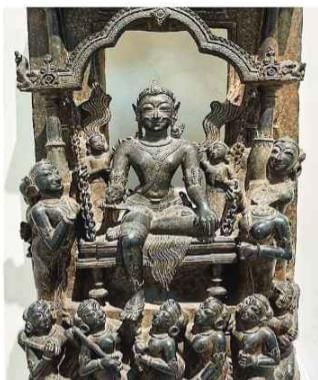 A statue depicting Narasimhadeva I seated on his throne, surrounded by attendants and musicians.
A statue depicting Narasimhadeva I seated on his throne, surrounded by attendants and musicians.
Hoysala Kingdom’s Defense:
- The Hoysala dynasty ruled much of southern India, mainly in present-day Karnataka, and resisted several invasions by the Delhi Sultanate.
- For some time, the Hoysalas remained the only major independent kingdom in the south, fending off outside control.
- However, repeated attacks and internal strife eventually weakened the Hoysalas.
- By the mid-14th century, the kingdom was absorbed by the powerful Vijayanagara Empire, which rose further south.
Did You Know?
The Hoysala dynasty’s name comes from a legendary story where a young man named Sala saved his guru by striking down a lion. The sculpture shows this heroic moment, remembered in Kannada folklore as “Hoy! Sala” (“Strike, Sala!”).
Emergence of Independent Sultanates:
- The Sultanate’s power was challenged by rebellions and the rise of several independent regional Sultanates.
- One significant development was the emergence of the Bahmani Sultanate in the mid-14th century, which controlled a large portion of the Deccan.
- Other notable regional sultanates were formed in Gujarat and Bengal, leading to a complex network of alliances and frequent warfare.
Resistance in Rajasthan:
- Parts of Rajasthan were never fully controlled by the Delhi Sultanate.
- In the 15th century, Rana Kumbha of Mewar became particularly well-known for his strong military leadership.
- He not only kept Mewar independent but also successfully repelled invasions from both the Delhi Sultanate and other regional sultanates.
- Rana Kumbha’s power ensured that areas like Mewar remained resistant and autonomous.
Did You Know?
Kumbhalgarh Fort in Rajasthan, built by Rana Kumbha, has a wall 36 km long—one of the longest in the world. Its location in the Aravalli hills made it a powerful Rajput stronghold.Kumbhalgarh Fort
The Vijayanagara Empire
The Vijayanagara Empire started in the 14th century, founded by brothers Harihara and Bukka, who rejected Delhi's rule and created an independent kingdom in southern India. Its growth was characterised by strong leadership, regional rivalries, and frequent wars to protect its land and power.
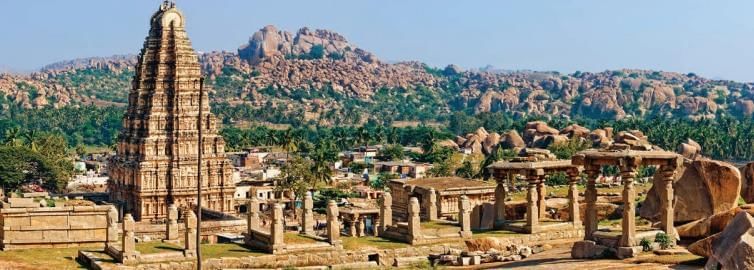 A section of the ruins of Vijayanagara city
A section of the ruins of Vijayanagara city
Formation of the Vijayanagara Empire:
- The Vijayanagara Empire was established in the 14th century by brothers Harihara and Bukka.
- They had previously been governors under Muhammad bin Tughlaq of the Delhi Sultanate.
- They rejected Delhi's authority and created an independent kingdom in southern India.
- According to folklore, they saw a hare chasing hounds in Hampi, symbolising unexpected strength. Their guru, Vidyaranya, advised them to build their capital there.
- Over time, their kingdom grew and became a significant political and military power in the area.
Rivalry with the Bahmani Sultanate:
To the north of the Vijayanagara Empire, the Bahmani Sultanate was a major rival, which later broke into five independent states known as the 'Deccan Sultanates':
- Bijapur
- Golconda
- Berar
- Ahmednagar
- Bidar
Each of these new sultanates was ruled by former Bahmani governors (known as tarafdars) who declared independence.
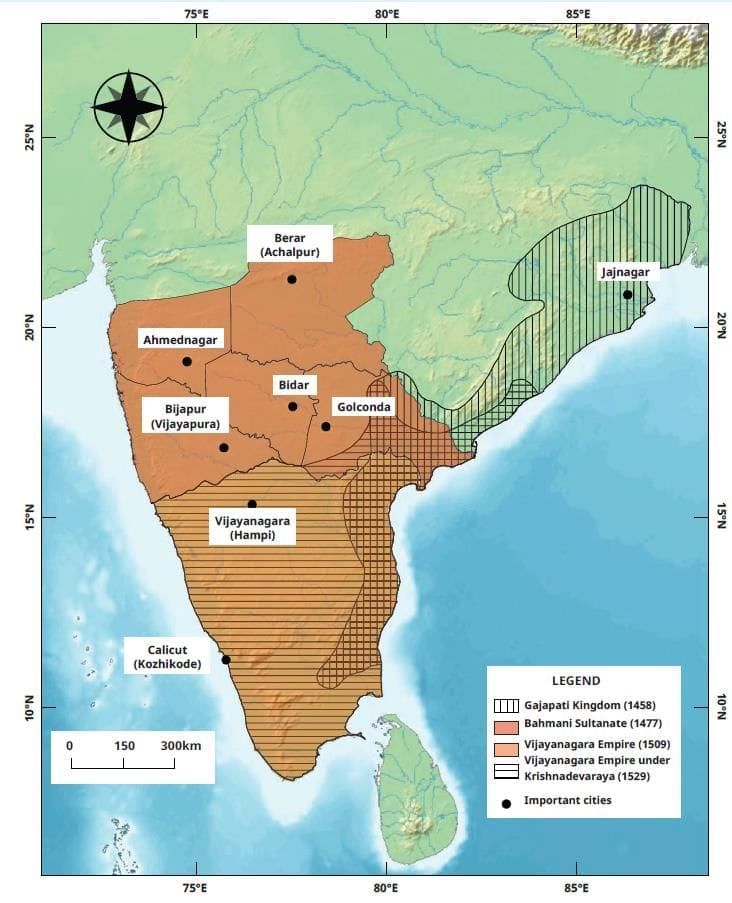 Kingdoms in Deccan and Vijaynagar Empire
Kingdoms in Deccan and Vijaynagar Empire
Conflicts with Other Powers:
- The rulers of Vijayanagara often fought against the Deccan Sultanates, especially Bijapur and Golconda.
- They also had clashes and territorial disputes with the Gajapati rulers of Odisha in the east.
- These ongoing conflicts helped Vijayanagara maintain its influence but also kept it engaged in military struggles.
Krishnadevaraya
Krishnadevaraya was the ruler of the Vijayanagara Empire during the 16th century. He led the empire to its height through military victories, promoting arts and temples, and effective governance. After his death in 1529, the empire declined and was eventually defeated at the Battle of Talikota in 1565, leading to its division into smaller kingdoms.
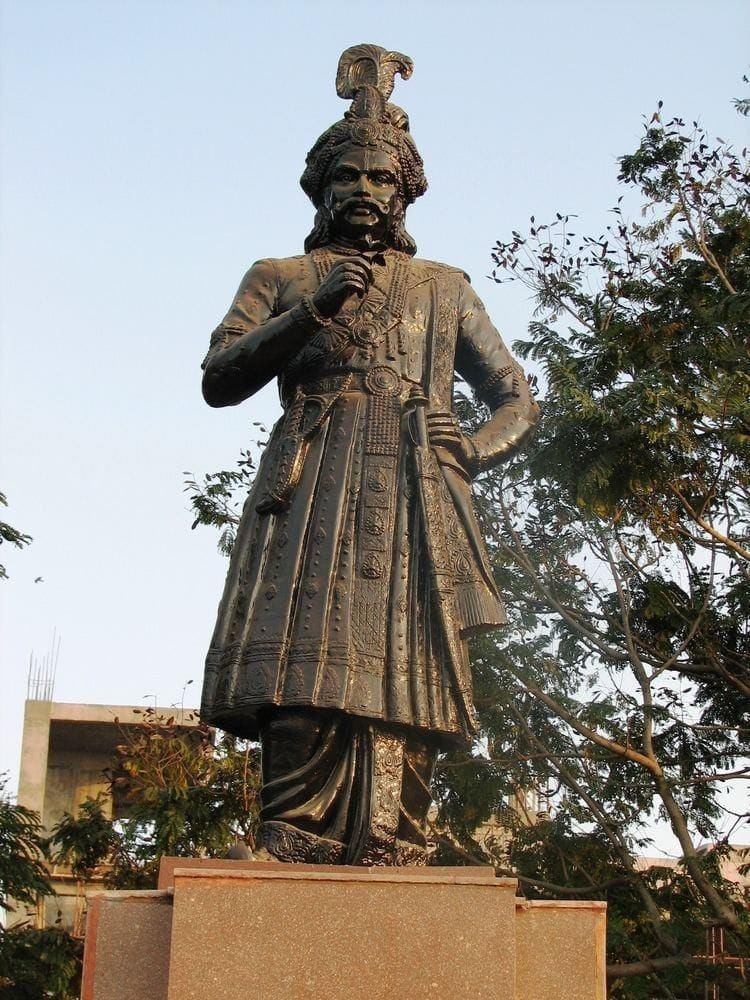 Krishnadevaraya
Krishnadevaraya
Rise to Power and Expansion
- Krishnadevaraya ruled the Vijayanagara Empire in the 16th century, bringing it to the height of its power and establishing it as the leading force in the Deccan.
- He significantly expanded the empire through military successes against neighbouring kingdoms, ensuring the safety and dominance of Vijayanagara in southern India.
Cultural Achievements:
- Krishnadevaraya was a strong supporter of culture and education. He patronised poets and scholars writing in Sanskrit, Telugu, and Kannada.
- He authored the epic Telugu poem Āmuktamālyada, which tells the story of the Tamil poet-saint Āḻvār and includes thoughts on Rājanīti (royal policy) and good governance.
- His reign is remembered as a time of cultural renaissance, marked by flourishing literature, arts, and scholarship throughout the empire.
Support for Temples:
- Krishnadevaraya supported religious life and architecture, providing funding to important temples like Tirupati in Andhra Pradesh and the famous Vitthala temple in Vijayanagara.
- The city of Vijayanagara was renowned for its magnificent temples, palaces, and grand structures, reflecting the empire’s architectural excellence.
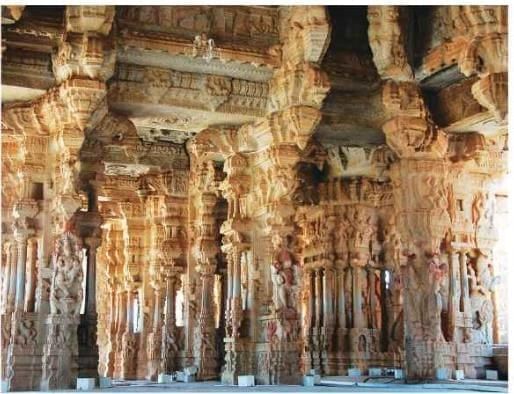 Vitthala Temple
Vitthala Temple
Decline and Fall:
- After achieving many victories, Krishnadevaraya passed away from illness in 1529.
- In 1565, a coalition of the Deccan Sultanates united and defeated Vijayanagara’s forces at the Battle of Talikota, led by his son-in-law, Ramaraya.
- The city was looted over several months; homes, shops, buildings, palaces, and most temples were destroyed, resulting in the massacre of many civilians; it was left in ruins.
- Following this, the empire split into smaller regions ruled by Nayakas (former military governors) and ultimately came to an end in the mid-17th century.
Did You Know?
Portuguese and other foreign travellers visited Vijayanagara for trade, especially selling prized horses. The king treated them well so they wouldn’t sell horses to rival kingdoms! One Portuguese traveller, Domingo Paes, wrote that Vijayanagara was as grand as Rome, full of gardens, lakes, busy markets, and countless people—a city rich in everything you could imagine.
The Mughals
The Mughal Empire began in 1526 when Babur defeated Ibrahim Lodi at the First Battle of Panipat, ending the Delhi Sultanate. After some challenges under Humayun and the rise of Sher Shah Suri’s Sur Empire, Babur’s grandson Akbar defeated Himu at the Second Battle of Panipat, firmly establishing Mughal rule in India.
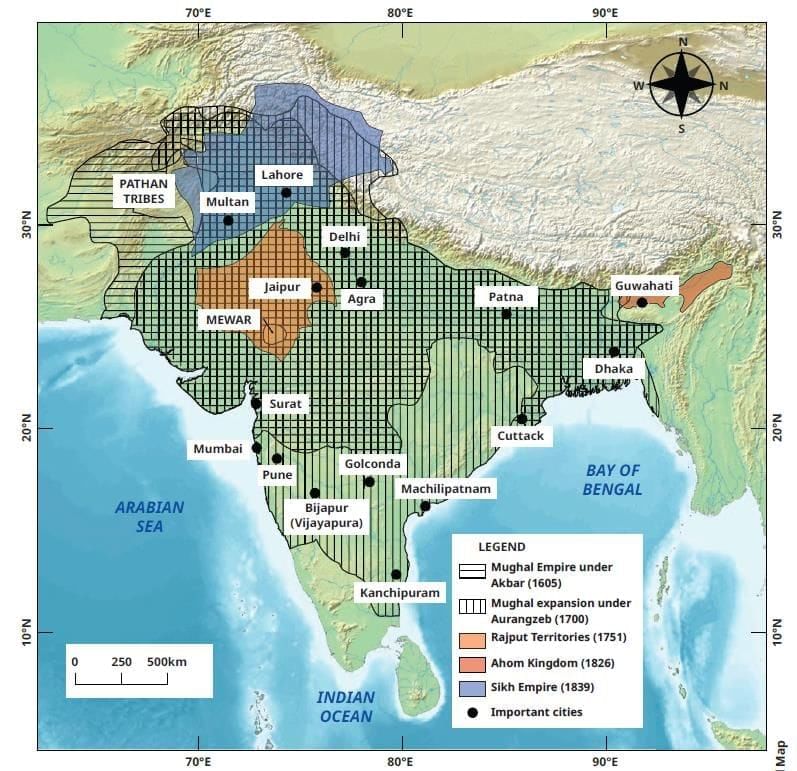 Mughals and Rise of Regional Powers
Mughals and Rise of Regional Powers
Formation of the Mughal Empire
- Babur, a Turkic-Mongol ruler from Samarkand, defeated Ibrahim Lodi in 1526 at the First Battle of Panipat.
- His army used gunpowder, field artillery, and matchlock guns, which were new in Indian warfare.
- This victory ended the Delhi Sultanate and marked the beginning of the Mughal Empire with Babur as its first ruler.
Babur and His Legacy
- Babur wrote Baburnama, an autobiography showing his love for poetry, architecture, birds, and fruit trees.
- Despite his cultured side, he was a brutal conqueror—he destroyed cities, killed many people, enslaved women and children, and took pride in building “towers of skulls” from the enemies he defeated.
- Though he found India less charming than Central Asia, he stayed because of its wealth of gold and silver.
- He also praised India’s healthy rainy season and the many skilled artisans living there.
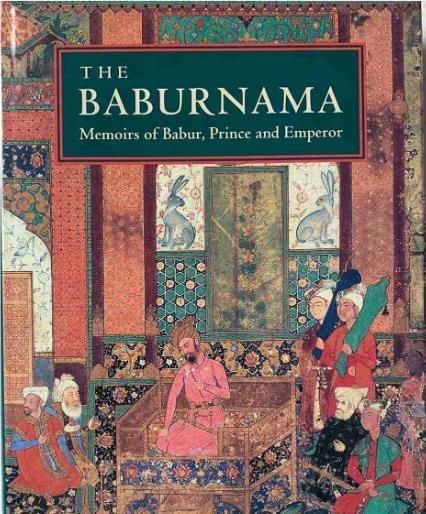 Baburnama
Baburnama
Humayun’s Struggles
- After Babur’s death in 1530, his son Humayun had difficulty keeping the empire united.
- Taking advantage of this, Sher Shah Suri, an Afghan leader, seized control of much of northern India and established the Sur Empire.
- Sher Shah introduced many reforms that lasted beyond his reign, but his empire was short-lived as Humayun regained power.
Sur Empire and Himu’s Brief Rule
- Sher Shah’s Sur Empire ruled northern India for a brief period.
- Himu, a clever military commander and minister under a Suri ruler, briefly captured Delhi and ruled as Hemchandra Vikramaditya.
- Himu won several battles but was eventually defeated by Akbar at the Second Battle of Panipat.
- After being injured, Himu was captured and beheaded by Akbar.
Akbar’s Rise
- Akbar, Babur’s grandson, defeated Himu and reclaimed Delhi for the Mughals.
- His victory marked the beginning of a strong and lasting Mughal rule in India.
Akbar
Akbar became emperor at age 13 in 1556 and expanded the Mughal Empire across India through conquests and smart alliances. His reign mixed harsh military campaigns with policies of tolerance, like ending the jizya tax and promoting peace among religions.
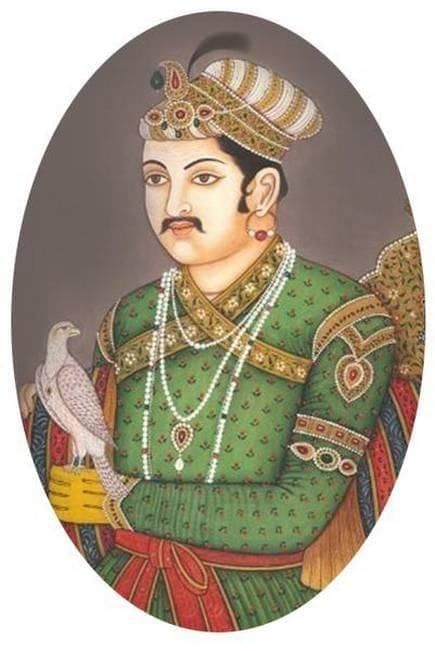 Akbar
Akbar
Early Conquests and Brutality:
- Became emperor in 1556 at age 13 after Humayun’s death, aiming to control the Subcontinent.
- Besieged Chittorgarh fort in Rajasthan for over five months, facing fierce Rajput resistance.
- After breaching the fort, ordered the massacre of ~30,000 civilians; surviving women and children were enslaved.
- Rajput women committed jauhar, jumping into fires to avoid capture.
What is Jauhar?
- Jauhar was when Rajput women, to avoid being captured or enslaved by invading armies, jumped into large fires.
- It was seen as a brave and honourable way to protect their dignity.
- For example, when Akbar captured Chittorgarh Fort, many Rajput women committed jauhar.
Political Strategies for Stability:
- Used marriage alliances with princesses of neighboring kingdoms to strengthen ties.
- Welcomed Rajput and regional leaders into his court and appointed Hindu officials to high posts.
- Abolished the jizya tax on non-Muslims and promoted sulh-i-kul (peace with all), encouraging tolerance of all faiths.
- Gained support from many Rajput rulers through these policies.
Cultural and Intellectual Contributions:
- Though illiterate, showed interest in Persian and Indian texts, inviting scholars to his court.
- Set up a ‘house of translation’ at Fatehpur Sikri, translating Sanskrit texts like the Mahābhārata (Razmnama), Rāmāyaṇa, Bhagavad Gītā, and Pañchatantra into Persian.
- The Persian Rāmāyaṇa included 176 miniature paintings.
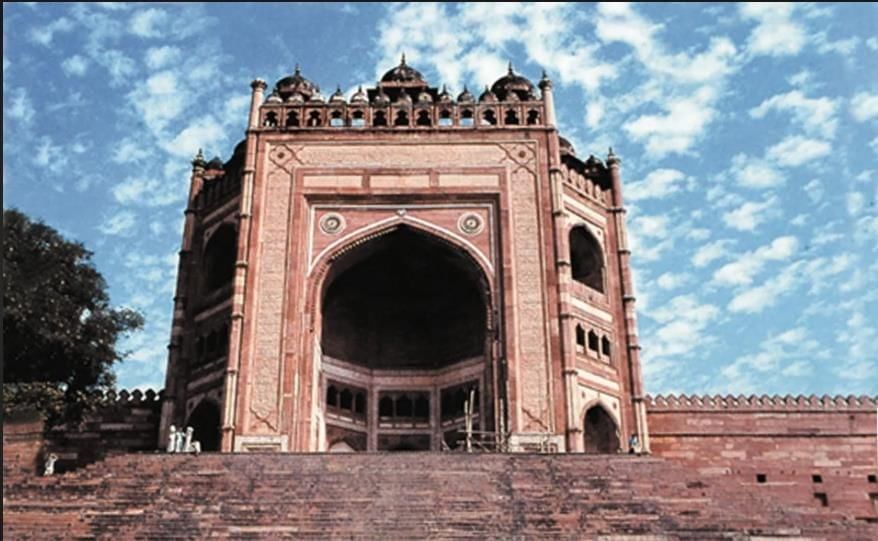 Fatehpur Sikri
Fatehpur Sikri
Later Reign and Successors:
- Ruled for nearly 50 years (1556–1605), with the middle period relatively peaceful.
- Launched campaigns in Kashmir, Sindh, Deccan, and Afghanistan in his final 15 years.
- His son Jahangir expanded into the Deccan and loved art; Shah Jahan built the Taj Mahal and Red Forts in Delhi and Agra.
- Mughal art, music, calligraphy, and miniature painting flourished under these rulers.
Aurangzeb
Aurangzeb became Mughal emperor in 1658 after defeating his brothers and imprisoning his father, Shah Jahan. He expanded the empire to its greatest size through years of war, but his strict religious policies and harsh rule sparked rebellions and drained resources. After his death in 1707, the empire quickly declined.
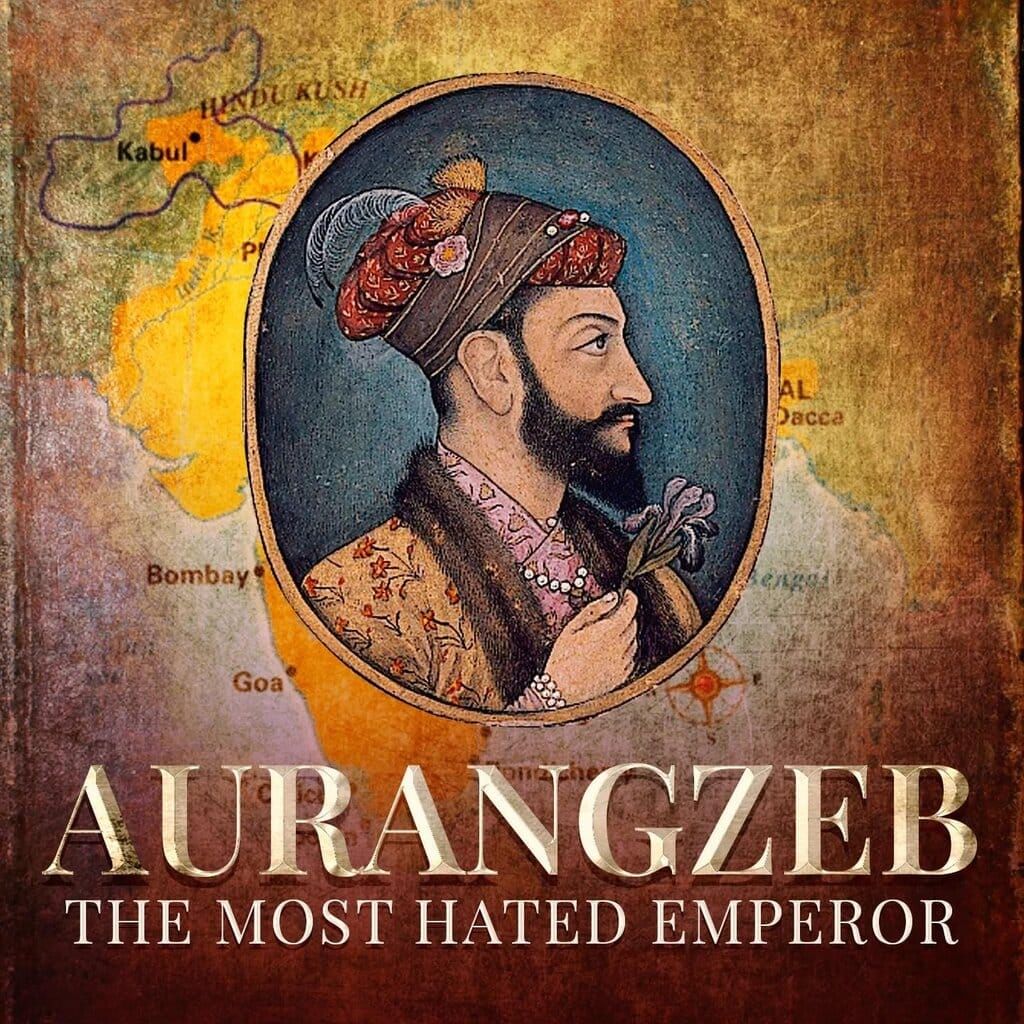
Rise to Power:
- Shah Jahan fell ill in 1657, sparking a succession battle among his sons.
- Aurangzeb defeated and executed his eldest brother Dara Shikoh, had another brother executed, and drove the third into exile.
- Imprisoned Shah Jahan in Agra Fort until his death and crowned himself emperor in 1658, taking the title ‘Alamgir’ (conqueror of the world).
Military Expansion:
- Conducted many campaigns, especially in the Deccan, expanding the Mughal Empire to its largest size.
- Spent the last 25 years of his life fighting wars in the Deccan, draining the empire’s treasury and administration.
- Constant wars weakened the empire’s stability.
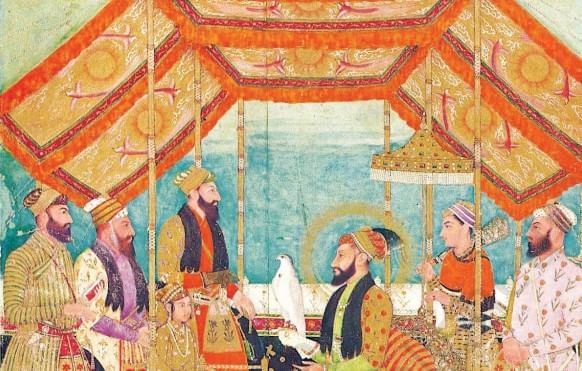 Aurangzeb in court, holding a hawk, with one of his sons standing in front of him.
Aurangzeb in court, holding a hawk, with one of his sons standing in front of him.
Religious Policies:
- A deeply religious Sunni Muslim, Aurangzeb banned music and dance in his court as un-Islamic.
- Reimposed the jizya tax on non-Muslims and a pilgrimage tax on Hindus, both previously abolished by Akbar.
- Ordered the destruction of Hindu, Jain, and Sikh temples, and persecuted Muslims of other sects, like Sufis, and Zoroastrians.
- Temples in Banaras, Mathura, and Somnath were destroyed in 1669.
Political and Religious Motives:
- Some scholars say his policies aimed to strengthen the empire politically, and he gave grants to some temples.
- His farmans (edicts) show a religious motive, ordering governors to demolish temples and stop non-Muslim teachings.
- His actions caused rebellions, contributing to the empire’s decline after his death in 1707.
Resistance to the Mughals
The Mughal Empire faced widespread rebellions as peasants and tribal groups resisted heavy taxes and Mughal expansion. Jat peasants in the north rose against oppression, while tribes like the Bhils and Gonds defended their lands with determination. Rani Durgavati, the Gond queen, became a legendary symbol of resistance for bravely fighting Mughal forces.
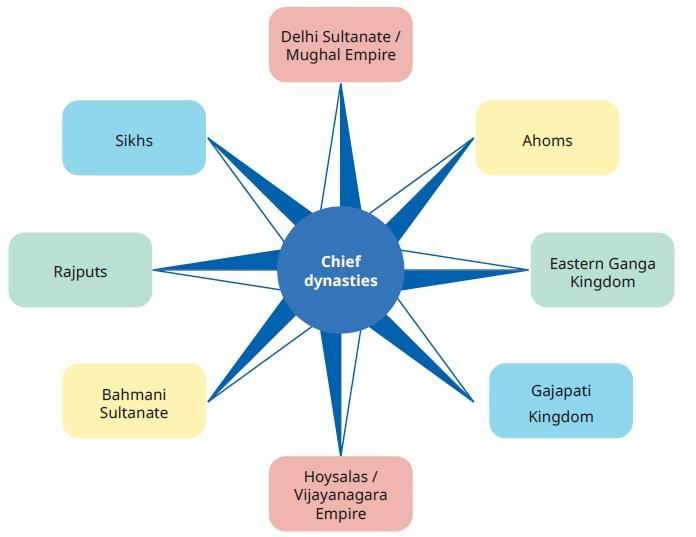
Jat Peasantry Rebellion:
- In the 17th century, Jat peasants in present-day western Uttar Pradesh, Haryana, and eastern Rajasthan rebelled against harsh Mughal rule.
- Killed an oppressive Mughal officer to protest exploitation.
- Fought a battle with 20,000 men against the Mughal army but were defeated, and their leader was killed.
Tribal Group Resistance:
- Tribes like the Bhils, Gonds, Santhals, and Kochs resisted Mughal attempts to take their lands or impose taxes.
- Some were subdued or joined the Mughal Empire, but those in forests, hills, or remote areas kept some independence.
- Hilly regions were difficult for Mughals to fully control.
Rani Durgavati’s Resistance:
- Rani Durgavati, queen of the Garha kingdom (a Gond kingdom in central India), ruled wisely, making her kingdom prosperous.
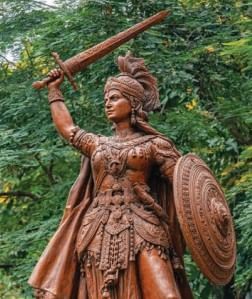 Rani Durgavati
Rani Durgavati - Maintained an army of 20,000 soldiers and 1,000 elephants, repelling several Mughal invasions.
- In 1564, led her troops against Akbar’s general, fighting bravely despite being outnumbered; wounded, she took her own life at age 40 to avoid capture.
- Her bravery made her a symbol of resistance and pride.
Surge of the Rajputs
The Rajputs of northwest India fiercely resisted invaders, rebuilding their kingdoms after earlier conquests. Leaders like Rana Sanga and Maharana Pratap fought bravely against Mughal rule, with Mewar standing as a symbol of independence. Supported by tribal allies like the Bhils, and despite some Rajput states allying with the Mughals, their constant resistance kept Mughal control weak in Rajasthan.
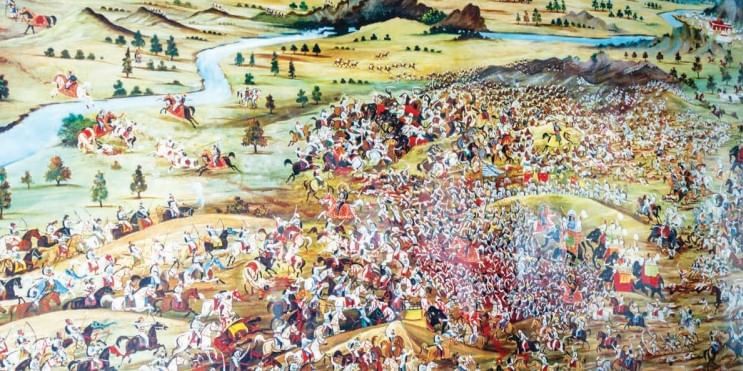 An artist’s impression of the Battle of Haldighati
An artist’s impression of the Battle of Haldighati
Rajput Resistance and Rebuilding:
- Rajputs in northwest India fought invaders, inheriting warrior traditions from earlier dynasties like the Pratiharas.
- Rebuilt kingdoms in Mewar and Marwar after the Khiljis’ conquests.
- Their heroic stories are told in popular ballads today.
Rana Sanga’s Leadership:
- In the early 16th century, Rana Sanga of Mewar unified several Rajput clans.
- Won many battles against sultans but was defeated by Babur at the Battle of Khanwa.
- His efforts strengthened Rajput unity against invaders.
Maharana Pratap’s Defiance:
- Maharana Pratap, ruler of Mewar, refused to accept Mughal rule despite inheriting a weakened kingdom.
- Fought the Mughals at the Battle of Haldighati in 1576; though defeated, he escaped and used guerrilla warfare from the Aravalli hills.
- Received support from Bhil tribes, who provided archers and knowledge of the terrain, earning a place in Mewar’s military emblem.
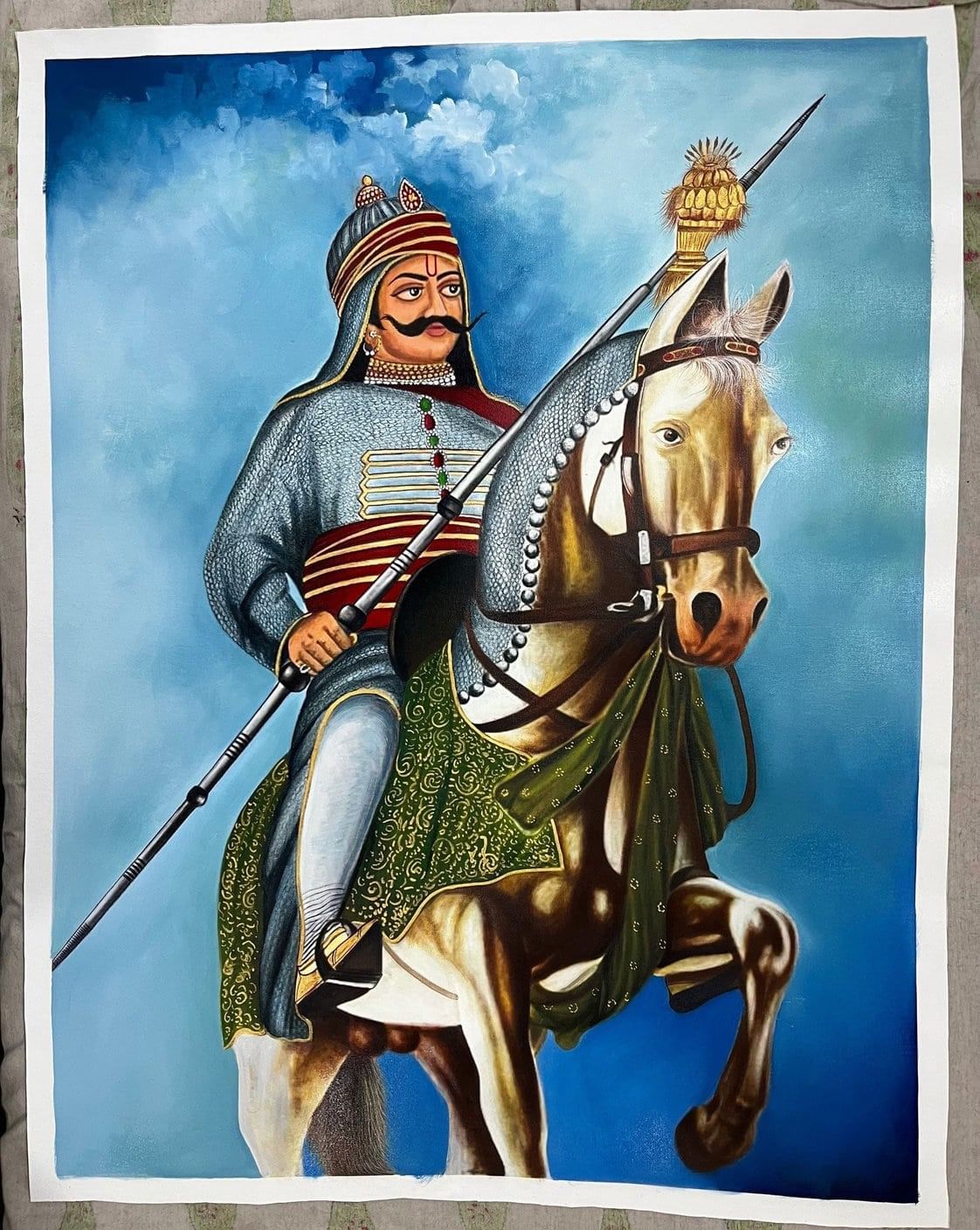 Maharana Pratap
Maharana Pratap
Rajput-Mughal Relations:
- Some Rajput states allied with the Mughals through diplomacy and marriage alliances.
- Mewar remained independent, resisting Mughal dominance.
- During Aurangzeb’s reign, Rajput nobles like Durga Das Rathore of Marwar rebelled to protect Jodhpur’s independence.
- Mughal authority stayed limited in Rajasthan due to Rajput resistance.
The Ahoms
The Ahom kingdom, formed in the 13th century in the Brahmaputra Valley, resisted Mughal and Sultanate expansion. Using their unique paik system and knowledge of the terrain, the Ahoms, led by figures like Lachit Borphukan, maintained their independence, notably in the Battle of Saraighat.
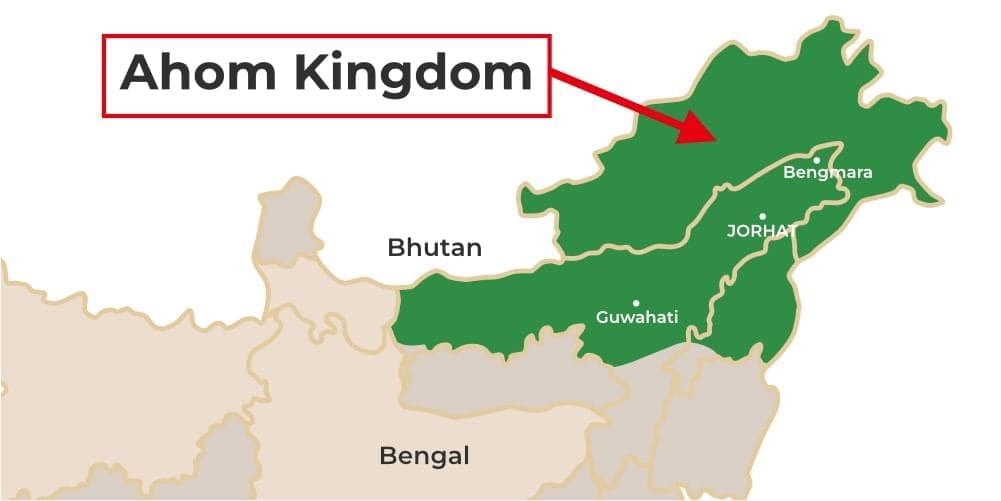
Formation of the Ahom Kingdom
- The Ahom ethnic group migrated from present-day Myanmar to the Brahmaputra Valley in the 13th century.
- Established the Ahom kingdom in present-day Assam.
- Every able-bodied man provided labor or military service in exchange for land rights.
- This system helped build public infrastructure and maintain a large force without a permanent army.
Resistance to Mughal and Sultanate Expansion
- Ahom rulers fiercely opposed Mughal and Sultanate attempts to expand into Northeast India.
- Used dense forests, hills, and rivers to their advantage.
- Their knowledge of the terrain helped them resist larger invading forces.
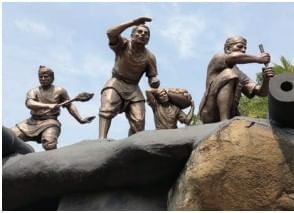 Statues depicting Ahom warriors during the Battle of Saraighat.
Statues depicting Ahom warriors during the Battle of Saraighat.
Battle of Saraighat (1671)
- Mughal emperor Aurangzeb sent forces that briefly captured the Ahom capital, Garhgaon.
- Led by commander Lachit Borphukan, 10,000 Ahom soldiers defeated a Mughal force of 30,000.
- Used guerrilla tactics and fought on the Brahmaputra River near present-day Guwahati.
- The victory at Saraighat ensured the Ahoms preserved their independence.
Ahom Contributions to Assam
- Assimilated local culture and promoted agriculture.
- Encouraged diverse faiths, enriching Assam’s traditions.
The Ahoms’ policies and resistance shaped Assam’s unique cultural and historical identity.
Did You Know?
Ram Singh, a Mughal general, greatly admired the skills of the Ahom warriors from Assam. He said, “Every Assamese soldier is expert in rowing boats, in shooting arrows, in digging trenches, and in wielding guns and cannons. I have not seen such specimens of versatility in any other part of India.” This shows how talented and well-trained the Ahom soldiers were in many different battle skills!
The Rise of the Sikhs
The Sikh community, founded by Guru Nanak in the 15th century, grew from a spiritual movement into a martial force due to Mughal persecution. Leaders like Guru Hargobind, Guru Tegh Bahadur, and Guru Gobind Singh resisted Mughal oppression, while Maharaja Ranjit Singh unified the Sikhs to form a powerful Sikh Empire in the 19th century.
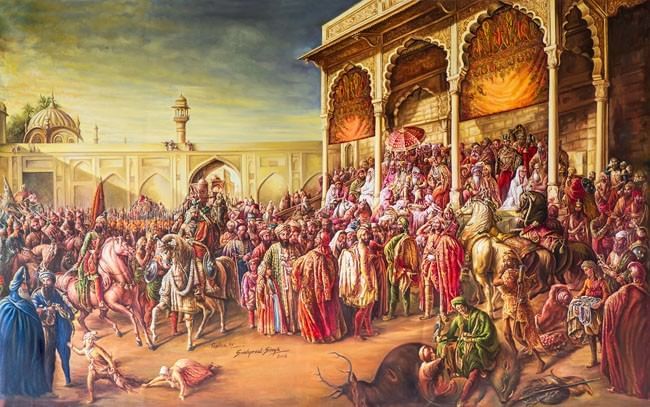 Rise of Sikhs
Rise of Sikhs
Foundation of Sikhism
- In 15th-century Punjab, Guru Nanak preached equality, compassion, and the oneness of God (Ik Onkār).
- His followers became known as Sikhs.
- Sikhism started as a peaceful spiritual movement focused on equality and devotion.
- Guru Nanak’s message emphasized unity and kindness for all.
Sikh Resistance to Mughal Persecution
- Guru Arjan, the fifth Guru, was tortured to death by Emperor Jahangir for supporting his rebellious son.
- This harsh act led to growing tensions between Sikhs and Mughals.
- Guru Arjan’s son, Guru Hargobind, introduced martial training and formed a Sikh army.
- Fought several battles against Mughal forces to defend the Sikh community.
Did You Know?
In this chapter, ‘Punjab’ means the large region now divided between India and Pakistan. The Sikh holy book, Guru Granth Sahib, was first compiled by Guru Arjan, with later additions by Guru Tegh Bahadur. It teaches that there is one God who made the earth a home for righteousness and urges Sikhs to practice truthfulness, compassion, humility, and self-control. For example: “Truth is high but higher still is truthful living.”Guru Granth Sahib
Guru Tegh Bahadur’s Sacrifice
- In 1675, Kashmiri Pandits sought Guru Tegh Bahadur’s help against religious persecution.
- The ninth Guru chose to protect them and faced arrest by Emperor Aurangzeb.
- Refused to convert to Islam despite torture and witnessing two disciples’ deaths.
- Publicly beheaded in Chandni Chowk, Delhi, for his defiance.
Guru Gobind Singh and the Khalsa
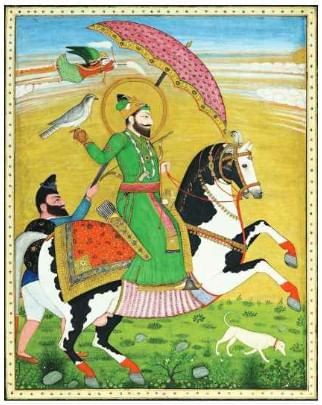 Miniature Painting of Guru Gobind Singh
Miniature Painting of Guru Gobind Singh
- Guru Gobind Singh, the tenth Guru, founded the Khalsa in 1699, a martial brotherhood dedicated to justice, equality, and defending the faith.
- The Khalsa frequently battled Mughal forces, suffering heavy losses.
- Strengthened Sikh identity and resistance against Mughal oppression.
Rise of the Sikh Empire
- As the Mughal Empire weakened, Sikh confederacies emerged in Punjab.
- Unified the confederacies in the early 19th century to form the Sikh Empire.
- Used military skill, diplomacy, and religious tolerance to expand the empire across Northwest India, including parts of Kashmir.
- The Sikh Empire resisted Mughal remnants and British expansion until the mid-19th century.
Did You Know?
Gurudwara Sis Ganj Sahib in Delhi’s Chandni Chowk marks the spot where Guru Tegh Bahadur, the ninth Sikh Guru, was beheaded by Aurangzeb in 1675. This gurudwara is a powerful symbol of faith and sacrifice, and the Sikh Regiment honors it every Republic Day by saluting it before the President since 1979.
Administering India
The Delhi Sultanate and Mughal Empire developed distinct systems to govern India, balancing central authority with local administration. The Sultanate relied on the sultan’s absolute power and the iqta system to manage taxes and the army, often burdening peasants. Key features include:
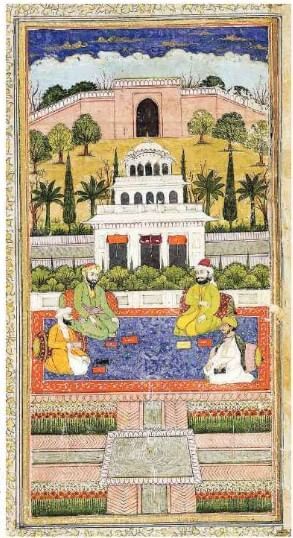 Manuscript painting of Abul Fazl, seated on a terrace with his completed chronicles before him
Manuscript painting of Abul Fazl, seated on a terrace with his completed chronicles before him
Administration under the Delhi Sultanate:
- Centered on the sultan, who had full political and military power.
- Duties included defending territories, collecting taxes, and staying connected with the people.
- A council of ministers managed departments, assisting the sultan.
- Ministers handled tasks like finance and public affairs.
Iqta System in the Sultanate:
- Territories were given to nobles (iqtadars) to collect taxes for the sultan’s treasury, mainly to fund the army.
- Created a network of local administrators loyal to the sultan, but positions were not hereditary.
- Taxes heavily burdened peasants, with reports of cruelty in collection.
- Taxes on trade and land were high for common people.
Mughal Administrative Framework:
- Akbar reorganized administration for better control, dividing the empire into twelve provinces (subahs).
- Key officials included the Diwan (finances), Mir Bakhshi (military), Khan-i-Saman (public works, trade, agriculture), and Sadr (justice, religion, education).
- Village-level self-governance continued with minimal interference.
- Checks and balances ensured officials worked efficiently.
Mansabdari System:
- Introduced by Akbar, where officers (mansabdars) maintained troops, elephants, horses, and camels based on their rank (mansab).
- Allowed quick assembly of armies without a permanent central force.
- Mansabdars were paid with land (jagirs), making them jagirdars.
- Regular inspections ensured officers followed rules.
Todar Mal’s Revenue System:
- Akbar’s finance minister, Todar Mal, conducted land and crop yield surveys to set fair crop prices.
- Introduced a systematic land survey across the empire to improve revenue collection.
- Strengthened the Mughal state by making tax collection efficient.
- Crop price surveys helped determine fair taxes.
Diversity in Administration:
- Despite Akbar’s tolerance, non-Muslims were a minority in high administrative posts, rarely exceeding one-third.
- Muslim officials of foreign origin were often favored over Indian Muslims.
- Non-Muslims held fewer top roles compared to foreign Muslims.
People’s Lives
From the 13th to 17th centuries, India thrived economically despite political changes, driven by agriculture, crafts, and trade networks. The Delhi Sultanate and Mughals built infrastructure and introduced new currencies, while temples supported local economies. However, heavy taxes and wars caused hardships for peasants and laborers, though communities maintained cultural traditions and lived peacefully across faiths.
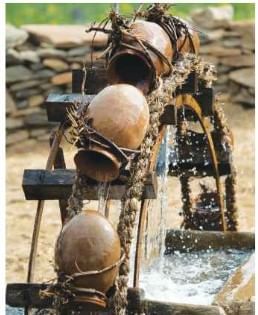 A Persian wheel used to draw water from wells or tanks to irrigate fields
A Persian wheel used to draw water from wells or tanks to irrigate fields
Economic Prosperity:
- India’s economy flourished due to agriculture, artisanal industries, and trade networks.
- Decentralized systems like śhreṇis (guilds), jātis (profession-based communities), and credit systems supported wealth.
- India was one of the world’s wealthiest regions, exporting goods like textiles.
Infrastructure Development:
- The Sultanate built roads, bridges, canals, and new cities in north India.
- The Mughals expanded these, introducing silver rupaya and copper dam as currency.
- Irrigation systems, like the Persian wheel, boosted farming productivity.
Agriculture and Revenue:
- Agriculture was the main economic source, with rulers collecting one-fifth to one-half of produce as land revenue.
- Expanded irrigation allowed multiple crops like rice, wheat, cotton, and sugarcane.
- Peasants faced famines, with relief depending on rulers’ kindness.
- Cotton fed a thriving textile industry.
Crafts and Trade:
- Craftspeople made weapons, utensils, jewelry, and ships for trade.
- Coastal towns like Calicut and Surat exported goods, importing silk, horses, and luxury items.
- The hundi system helped merchants transfer funds safely across borders.
- Marwari traders used credit systems to operate across regimes.
Did You Know?
A hundi was an ancient written order to pay money to someone. It could be used across different kingdoms, allowing people to send payments without carrying cash. This system was an early form of banking and worked smoothly along trade routes, often without involving the rulers.
Temples as Economic Centers:
- Temples were hubs for markets, learning, and trade, funded by rulers’ land and wealth donations.
- Managers used funds for irrigation, tanks, and pilgrim accommodations like dharmashālās.
- Temples provided credit to merchants for maritime trade.
Economic Hardships:
- By the late 1600s, heavy taxes and payments left peasants with little produce, leading to land loss and bonded labor.
- Craftspeople and laborers faced harsh conditions; wealth was concentrated among rulers and merchants.
- Frequent wars displaced people, adding to their struggles.
Cultural and Social Life:
- Communities maintained traditions in art, literature, and spirituality, adapting to changes.
- People of different faiths lived peacefully, depending on each other economically.
- Clashes occurred over desecrated sacred sites, but shared cultural heritage grew through interaction.
- Communities revived traditions despite political instability.
Key Points to Remember: Before We Move On
- Turkic, Afghan, and Mughal invasions caused destruction, ended old dynasties, and reshaped India’s political boundaries through wars and alliances.
- Buddhists, Jains, Hindus, Sikhs, Zoroastrians, and tribal groups faced persecution, though some rulers showed religious tolerance.
- Agriculture and trade expanded, making India wealthy and globally connected, but common people faced harsh conditions due to taxes and wars.
- Indian society rebuilt towns, cities, and temples, blending indigenous and foreign cultural elements.
- Art, architecture, music, and painting flourished, creating a shared cultural heritage despite political instability.
|
87 videos|558 docs|53 tests
|
FAQs on Reshaping India’s Political Map Chapter Notes - Social Studies (SST) Class 8
| 1. What were the key factors that led to the rise of the Delhi Sultanate? |  |
| 2. How did the Vijayanagara Empire resist the expansion of the Delhi Sultanate? |  |
| 3. Who was Krishnadevaraya and what was his significance in the Vijayanagara Empire? |  |
| 4. What were the main policies of Akbar during the Mughal Empire? |  |
| 5. How did resistance to the Mughals manifest in India, and what were its consequences? |  |


